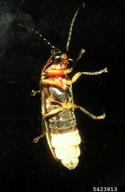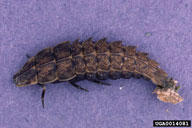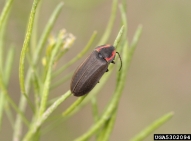How do you know summer has finally arrived? For me, it is sitting on the porch on a warm evening and seeing the first flicker of a firefly. When conditions are right, that first flash of light is a prelude to dozens or more of these insects making their dazzling night-time display. Fireflies, also known as lightning bugs, are neither flies nor bugs. They are nocturnal beetles in the family Lampyridae. Growing no more than one inch in length, fireflies have soft and pliable forewings (elytra), distinguishing them from most other beetles which have hard elytra. Elytra protect the hindwings that are used for flight. Fireflies are found worldwide with about 23 genera and 200 species of fireflies in North America. Some fireflies live in the western U.S., but they are most abundant in the eastern United States, ranging from Florida to southern Canada.
How and why fireflies glow

Fireflies make their magical lights through bioluminescence, a chemical reaction that produces light in living organisms. Bioluminescence is not to be confused with phosphorescence which does not involve a chemical reaction. In phosphorescence light is absorbed and then re-emitted. Most bioluminescent creatures dwell in the ocean and include fish, squid, bacteria, plankton and jellies. Marine bioluminescent organisms emit a blue-green light to ward off enemies or to lure prey. Fireflies are terrestrial and have organs in the underside of their abdomens where a chemical called luciferin and an enzyme called luciferase, combine with oxygen in cells called photocytes. This chemical action in the cells produces light in the yellow spectrum, creating the warm flash of fireflies. Entomologists are still examining the intricacies of firefly bioluminescence, but believe the amount of oxygen deployed controls the flashing. Bioluminescence is “cold light”, meaning it produces very little heat. While we are fascinated watching the dancing lights, flashing is serious business for fireflies – it is the communication system they use to find mates. Their flashing is orderly and controlled rather than random. The intensity and length of the flashes vary by species, creating unique signaling systems. Fireflies rest on foliage during the day and start their nocturnal mating ritual around dusk. The males fly at the determined height for the species and flash their unique signals. The females are on the ground or in low vegetation watching for the flash that signifies the right species is nearby. When she sees the right signal, she flashes back, the male responds, and then flies down to meet her. A typical backyard species is Photinus pyralis, or the “The Big Dipper”. He flies in a “J” pattern, flashing his light for one second every 5 seconds. The female of the species waits on vegetation until she sees his special flash. She waits 2 seconds, then makes a half-second flash at the 3rd flash. The male knows she is there and available. Some firefly species may flash all night, others flash only 20 minutes or so at dusk, and some have multiple signaling systems. Some species even synchronize their flashing. In North America there are two areas where the synchronized species are abundant, making a spectacular show: Photinus carolinus, the “Smokies synchronous fireflies”, are found in the Appalachian Mountains, especially in Great Smoky Mountains National Park, and Photuris frontalis, the “snappy syncs”, can be seen in Congaree National Park, South Carolina.
Life history of fireflies

When firefly mating is successful, the fertilized female finds a damp place in soil, leaf litter, or rotting logs to lay her eggs. Fireflies go through all four stages of metamorphosis: egg, larvae, pupae, and adult, with up to 95% of their lives spent in the larval stage. Larvae can live up to two years in the soil but most adults only live a few weeks. Larvae overwinter in the soil, pupate in the spring, and finally emerge as adult fireflies in early summer. Fireflies may be known for their beauty, but they are no shrinking violets. They are active participants in the food web. These beneficial insects help control pests. Many adults do not eat and die soon after mating and laying eggs. The help comes from the larvae who are voracious predators of soft-bodied invertebrates. While we are entertained by the adults, the larvae are busy on the soil surface or under vegetation feeding on snails, slugs, cutworms, and other soil-dwelling insects. Some firefly larvae are bioluminescent and are called glowworms. Their glow serves as a warning to predators that they are dangerous. The larvae paralyze their prey with neurotoxins and then secrete enzymes that liquify their meal before they eat it. Adult fireflies protect themselves from predators by exuding unpleasant tasting chemicals called lucibufagins. Birds and other predators quickly learn to avoid this distasteful meal. Fireflies in the species Photuris cannot manufacture these defensive chemicals so have adapted another lethal method of deterring prey. Once a female has mated, she mimics the flash of a Photinus then eats the male that responds. By eating the male, she acquires the lucibufagins needed to protect herself and her offspring. Not every species of fireflies is bioluminescent. Dark fireflies do not make light and fly during the day, locating mates by scent. Their eggs and larvae, however, glow.
Threats to fireflies
When I was a child, summer nights were aglow with hundreds of fireflies. There were so many lighting the sky, it was easy to scoop dozens out of the air and place them in bottles to create a living lantern. Scientists wanted to know more about the luminescence of fireflies and, with no thought of species decline, in the 1960’s labs in Baltimore and St. Louis offered bounties to individual children, Boy Scouts, 4-H and other groups to capture and send fireflies in for study. But decline the fireflies did and hundreds of millions were destroyed for scientific exploration. While mass slaughter has ceased, like butterfly, bee and other insects, firefly populations have continued to diminish. Now I am lucky to see six to a dozen fireflies in my yard on a summer night. Here are the biggest threats to fireflies, in order of severity:
Loss of habitat: As urban and suburban areas grow, impervious surfaces of roads, sidewalks, parking lots, and buildings replace green spaces, decreasing breeding and overwintering sites. Fireflies prefer tall grassy areas, but in suburban areas, grass is cut short and landscapes are mostly barren lawn, providing few places for fireflies to live and reproduce.
Light pollution: Lights at night are a detriment to firefly survival. Ironically, their bioluminescence, used as signaling for mates, makes fireflies especially vulnerable to the effects of artificial light. Studies have shown that fireflies tend to be drawn to artificial lights at night and once in their glow, stop flashing, as if it is daytime. They don’t mate so reproduction ceases and populations decrease. LED lights are environmentally friendly but particularly deadly as their bright blue lights lure fireflies and other insects into their destructive glow.
Pesticides: Pesticides and insecticides used on lawns and other plants are not species-specific and harm beneficial as well as insects thought to be a problem. Ingested pesticides disrupt the metabolism and development of both the egg and larval stages of fireflies and can cause death.
Climate change: Fireflies thrive in temperate climates. Warm, wet summers and cold winters provide the ideal conditions for the breeding and the survival of eggs and larvae. Climate change, which causes a rise in temperatures and both drought and excessive moisture, can disrupt breeding cycles. Either of these conditions also degrades habitat, reducing viable living spaces.
Create a sanctuary for fireflies
We rely on researchers to learn how fireflies and other insects live. As much as we hope city, town, and county planners will preserve native areas, all too often trees and shrubs are clearcut for more development. In the face of this loss, individuals can do their part by creating a habitat in their own yards that will encourage fireflies to thrive. By creating a haven for fireflies, you will also attract bees, butterflies, moths, birds, and other wildlife. Here are things you can do:

- Turn off outdoor lights. If lights are needed, install motion sensor lights or lights with a shield that points the glow downward. Avoid bulbs that emit blue light. Close curtains at night to reduce light spilling outside. Encourage your community to do the same.
- Fireflies like things long and lanky. Mow grass less frequently and mow no shorter than 4 inches. Manicured lawns and heavy layers of mulch are poor habitat for fireflies. While mulch can preserve moisture and suppress weeds, it prevents female fireflies from laying eggs in the soil, so do not apply more than 2-3 inches. Leave parts of your yard un-mulched and other areas un-mown and a little wild.
- Keep your leaves. In the fall, rake fallen leaves off your lawn and onto your garden beds. Larvae need soil and leaf litter to find the snails, slugs, worms and other soft-bodied insects hiding there. Do not chop the leaves as firefly larvae and other insects overwinter in leaf duff.
- Control insect pests with non-chemical solutions. Most insects are not harmful so controls should be used selectively and carefully. With a landscape rich in native plants, insect populations are balanced between harmful and beneficial insects so few, if any, human controls are needed. Avoid using herbicides or insecticides on your lawn.
- Promote healthy soil by introducing organic matter such compost or leaf mold to add nutrients and lighten soil. Soft, nutritious soil allows firefly larvae to thrive.
- Create a brush pile for adults and larvae.
- Most importantly, reduce your lawn and plant beds rich in native trees, shrubs, grasses, and perennials to provide feeding and breeding sites for both adults and larvae. In the wild, fireflies live at the edge of woods, often near ponds, streams, rivers, and marshes. They need moisture and just a little will do. Small depressions hold water and the deep roots of native plants help retain moisture. Include tall native grasses with long stems give to fireflies a launching pad for flying. Try planting switchgrass (Panicum virgatum), side oats grama (Bouteloua,) Indian grass (Sorghastrum nutans), or sea oats (Chasmanthium latifolium). The native flowering perennials that attract pollinators also provide habitat for fireflies. Create a wildflower meadow with tall, leafy perennials such as black-eyed susan (Rudbeckia), coneflowers (Echinacea), asters (Symphyotrichum), goldenrod (Solidago), boneset (Eupatorium) and cardinal flower (Lobelia cardinalis). Fireflies love native pine trees which provide a dark, safe places for resting and hiding during the day. Woody shrubs such as buttonbush (Cephalanthus occidentalis) offer females broad leaves for for hiding and flashing.
Most youth today have not experienced the magnificent display of hundreds of fireflies dancing across the night sky. A little effort in restoring habitat in your yard can help fireflies return and, with a wildlife show both night and day, who could ask for a more pleasing paradise?
Featured Images Courtesy of Bugwood
Resources
A Summer Light Show Dims: Why Are Fireflies Disappearing, Yale University
About Fireflies, Xerces Society
Bioluminescence, National Geographic
Firefly Populations at Risk Due to Climate Change, Urban Development, Penn State University
Fireflies (Lampyridae), Wisconsin Horticulture
How Fireflies Glow and What Signals They’re Sending, N. C. State
Save the Fireflies, U. S. Fish and Wildlife Service